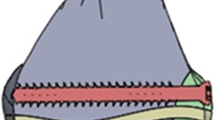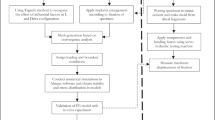Abstract
In this study, the biomechanical effects of three different configurations (K-wire, stainless steel screws, and titanium screws), which are used for stabilizing Salter–Harris (SH) type 3 epiphyseal fracture of distal femur after reduction process, on the epiphyseal plate and fracture line have been investigated under axial, rotational, and bending forces to determine the most advantageous configuration. Three different configurations have been modeled using SolidWorks, and computer-aided numerical analyses were performed by finite-element analysis software. For each configuration, mesh process, boundary conditions, and material model have been applied in finite-element analysis software. In addition, von Mises stress values on growth of epiphyseal plate and K-wire have been calculated. According to the results obtained, it has been found particularly advantageous to use the fixation shape of configuration with screw. In addition, the fixation shape of K-wire configuration was found to be disadvantageous in the SH type 3 epiphyseal fractures.











Similar content being viewed by others
References
Mann DC, Rajmaira S (1990) Distribution of physeal and nonphyseal fractures in 2650 long-bone fractures in children aged 0–16 years. J Pediatr Orthoped 10(6):713–716
Peterson HA, Madhok RBJ, Ilstrup DM, Melton LJ (1994) Physeal fractures: Part 1. Epidemiology in Olmsted County, Minnesota, 1979–1988. J Pediatr Orthoped 14(4):423–430
Basener CJ, Mehlman CT, DiPasquale TG (2009) Growth disturbance after distal femoral growth plate fractures in children: a meta-analysis. J Orthop Trauma 23(9):663–667
Eid AM, Hafez MA (2002) Traumatic injuries of the distal femoral physis. Retrospective study on 151 cases. Injury 33(3):251–255
Dahl WJ, Silva S, Vanderhave KL (2014) Distal femoral physeal fixation: are smooth pins really safe? J Pediatr Orthoped 34(2):134–138. doi:10.1097/BPO.0000000000000083
Liu RW, Armstrong DG, Levine AD, Gilmore A, Thompson GH, Cooperman DR (2013) An anatomic study of the distal femoral epiphysis. J Pediatr Orthoped 33(7):743–749. doi:10.1097/BPO.0b013e31829d55bf
Lombardo SJ, Harvey J Jr (1977) Fractures of the distal femoral epiphyses. Factors influencing prognosis: a review of thirty-four cases. J Bone Joint Surg Br 59(6):742–751
Herring JA (2002) Lower extremity injuries. In: Tachdjian’s pediatric orthopaedics. 3rd edn. W.B. Saunders Company, pp 2327–2334
Zionts LE (2003) Fractures and dislocations about the knee. In: Skeletal trauma in children. 3rd edn. Saunders, pp 443–449
III CRW (2014) Wheeless’ textbook of orthopaedics, orthopaedic references and discussions for physicians
Arkader A, Warner WCJ, Horn BD, Shaw RN, Wells L (2007) Predicting the outcome of physeal fractures of the distal femur. J Pediatr Orthoped 27(6):703–708. doi:10.1097/BPO.0b013e3180dca0e5
Garcés GL, Mugica-Garay I, López-González Coviella N, Guerado E (1994) Growth-plate modifications after drilling. J Pediatr Orthop 14(2):225–228
Janarv PM, Wikström B, Hirsch G (1998) The Influence of transphyseal drilling and tendon grafting on bone growth: an experimental study in the rabbit. J Pediatr Orthoped 18(2):149–154
Goffin JM, Pankaj P, Simpson AH (2013) The importance of lag screw position for the stabilization of trochanteric fractures with a sliding hip screw: a subject-specific finite element study. J Orthopaed Res 31(4):596–600. doi:10.1002/jor.22266
Atmaca H, Kesemenli C, Memişoğlu K, Özkan A, Celik Y (2013) Changes in the loading of tibial articular cartilage following medial meniscectomy: a finite element analysis study. Knee Surg Sport Traumatol Arthrosc 21(12):2667–2673. doi:10.1007/s00167-012-2318-6
ANSYS Workbench 14.0 (2014) AnsysWorkbench Material Library
Yuan-Kun T, Yau-Chia L, Wen-Jen Y, Li-Wen C, You-Yao H, Yung-Chuan C, Li-Chiang L (2009) Temperature rise simulation during a Kirschner pin drilling in bone. In: Bioinformatics and biomedical engineering, 2009. ICBBE 2009. 3rd international conference on, Beijing 11–13 June 2009. p 1–4. doi:10.1109/icbbe.2009.5163563
Peña E, Calvo B, Martínez MA, Palanca D, Doblaré M (2005) Finite element analysis of the effect of meniscal tears and meniscectomies on human knee biomechanics. Clin Biomech 20(5):498–507. doi:10.1016/j.clinbiomech.2005.01.009
Seyhan Fahri, Göksan SB (2002) Çocuk Kırıkları. In: Travmatoloji Ortopedik (ed) AK A. Nobel Tıp Kitabevleri, İstanbul, pp 89–101
Salter RB, Czitrom A, RB W (1979) Fractures involving the distal femoral epiphyseal plate. In: Injury to the adolescent knee. Williams & Wilkins Co, Baltimore
Garrett BR, Hoffman EB, Carrara H (2011) The effect of percutaneous pin fixation in the treatment of distal femoral physeal fractures. J Bone Joint Surg Br 93(5):689–694
Wall EJ, May MM (2012) Growth plate fractures of the distal femur. J Pediatr Orthoped 32:S40–S46. doi:10.1097/BPO.1090b1013e3182587086
Author information
Authors and Affiliations
Corresponding author
Ethics declarations
Funding
There is no funding.
Conflict of interest
There is no conflict of interest.
Additional information
Technical Editor: Estevam Las Casas.
Arif Gok: Senior Author.
Rights and permissions
About this article
Cite this article
Gok, K., Inal, S., Gok, A. et al. Biomechanical effects of three different configurations in Salter Harris type 3 distal femoral epiphyseal fractures. J Braz. Soc. Mech. Sci. Eng. 39, 1069–1077 (2017). https://doi.org/10.1007/s40430-016-0666-8
Received:
Accepted:
Published:
Issue Date:
DOI: https://doi.org/10.1007/s40430-016-0666-8




